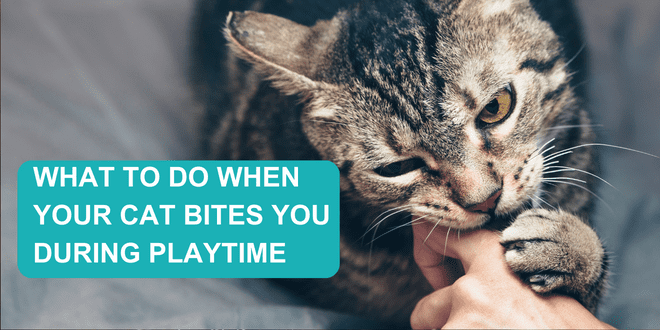
Fingers Aren’t Toys When Playing With Your Cat
The first rule is to never use your fingers as toys. Even if your cat doesn’t bite hard it sends a mixed message that chomping down on flesh is acceptable.
Use only fishing pole-type toys so that there’ll be a safe distance between your fingers and your cat’s teeth. Even small toys aren’t good for interactive playtime because your cat can easily get too excited and lose track of where the toy leaves off and the skin begins. Safe those fuzzy little mice toys for kitty’s solo playtime.
Don’t even get in the habit of using your fingers as toys when they’re covered by a sheet or blanket. It still sends the wrong message to the cat. Additionally, if your cat is allowed to bite the fingers that are wiggling under the bed sheets, kitty will think it’s allowable to bite toes as well and that may happen when you’re moving your feet in your sleep and NOT during a game with kitty. Imagine what an unpleasant surprise that’ll be!
When Your Cat Bites
If your cat has her teeth on your hand, don’t pull away because that’ll cause her to instinctively bite down more. Prey tries to pull away and you don’t want to imitate prey when your hand is in your cat’s mouth. Instead, freeze, say a high pitched “ouch” to momentarily confuse your cat and let her know this has caused pain and the game is no longer fun. At the same time, gently push your hand toward your cat’s mouth. This will cause her to disengage. Moving your hand in the direction of the cat is totally confusing because prey would never act that way. This action is what will cause your cat to release the hold on you.
Educate Everyone in the Family About How to Play With the Cat
Be consistent with what your cat is and isn’t allowed to bite on during play. Have a supply of small toys (such as fuzzy mice and crinkle balls) for solo play, and a supply of fishing pole-design toys for when she will be engaging in interactive playtime with family members. The best way to train a cat not to bite is to avoid putting her in that position in the first place. Make sure all family members know the rules as well so the cat’s training process will be consistent.
Need More Help?
For more specific information on proper playtime techniques and how to engage in fun interactive play sessions with your cat, refer to the books by Pam Johnson-Bennett. Pam’s books are available at bookstores and online. We’ve included Amazon links here on our website.
If you have a question regarding your cat’s health, please contact your veterinarian. This article is not intended as a replacement for your cat’s veterinary care. This article is for information purposes only and not offering medical advice.




